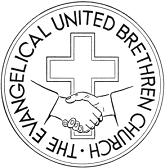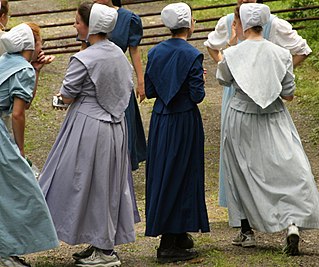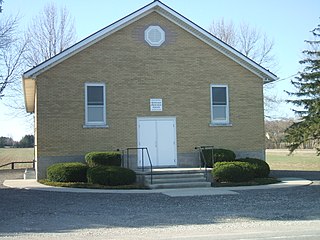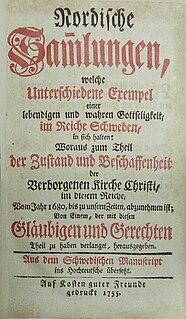Related Research Articles

The Mennonites are members of certain Christian groups belonging to the church communities of Anabaptist denominations named after Menno Simons (1496–1561) of Friesland. Through his writings, Simons articulated and formalized the teachings of earlier Swiss founders, with the early teachings of the Mennonites founded on the belief in both the mission and ministry of Jesus, which the original Anabaptist followers held with great conviction, despite persecution by various Roman Catholic and Protestant states. An early set of Mennonite beliefs was codified in the Dordrecht Confession of Faith in 1632, but the various groups do not hold to a common confession or creed.

The Church of the Brethren is a Christian denomination with origins in the Schwarzenau Brethren that was organized in 1708 by Alexander Mack in Schwarzenau, Germany, as a melding of the Radical Pietist and Anabaptist movements. The denomination holds the New Testament as its only creed. Historically, the church has taken a strong stance for nonresistance or pacifism—it is one of the three historic peace churches, alongside the Mennonites and Quakers. Distinctive practices include believer's baptism by trine immersion; a threefold love feast consisting of feet washing, a fellowship meal, and communion; anointing for healing; and the holy kiss.

The Evangelical United Brethren Church (EUB) was a North American Protestant church from 1946 to 1968. It was formed by the merger of the Evangelical Church and the Church of the United Brethren in Christ. The United Brethren and the Evangelical Association had considered merging off and on since the early 19th century because of their common emphasis on holiness and evangelism and their common German heritage. In 1968, the United States section of the EUB merged with the Methodist Church to form the United Methodist Church, while the Canadian section joined the United Church of Canada.

The Dunkard Brethren are a small group of primarily American conservative Schwarzenau Brethren, which organized in 1926 when they withdrew from the Church of the Brethren in the United States. In 1980 they had approximately 900 members in 25 congregations, primarily in mid-Atlantic and midwestern states that had been areas of German settlement in the colonial and later periods.

The Brethren in Christ Church (BIC) is an River Brethren Christian denomination with roots in the Mennonite church, Radical Pietism, and Wesleyan holiness. They have also been known as River Brethren and River Mennonites.
The Missionary Church is an evangelical Christian denomination of Anabaptist origins with Wesleyan and Pietist influences.

The Old Order River Brethren are a small Old Order River Brethren denomination of Christianity with roots in the Mennonite Church and the Radical Pietist movement of the Schwarzenau Brethren.
The Church of the United Brethren in Christ is an evangelical Christian denomination with churches in 17 countries. It is Protestant, with an episcopal structure and Arminian theology, with roots in the Mennonite and German Reformed communities of 18th-century Pennsylvania, as well as close ties to Methodism. It was organized in 1800 by Martin Boehm and Philip William Otterbein and is the first American denomination that was not transplanted from Europe. It emerged from United Brethren churches that were at first unorganized, and not all of which joined this church when it was formally organized in 1800, following a 1789 conference at the Otterbein Church.
The Bible Fellowship Church is a conservative pietistic Christian denomination with Mennonite roots.
The Conservative Mennonite Conference (CMC) is a Christian body of Conservative Mennonite churches in the Anabaptist tradition. Its members are mostly of Amish descent.
The denomination known as the United Christian Church is a small evangelical body of Christians with roots in the Radical Pietistic movement of Martin Boehm and Philip William Otterbein. This group may often be confused with local congregations and churches of other denominations that also use the name United Christian Church.

The River Brethren are a group of historically related Anabaptist Christian denominations denominations originating in 1770, during the Radical Pietist movement among German colonists in Pennsylvania. In the 17th century, Mennonite refugees from Switzerland had settled their homes near the Susquehanna River in the northeastern United States.
The Fellowship of Evangelical Bible Churches (FEBC) is a small evangelical Christian denomination with an Anabaptist Mennonite heritage. Most of the denomination's approximately 5000 members are in congregations located in the U.S. and Canada.

Peace churches are Christian churches, groups or communities advocating Christian pacifism or Biblical nonresistance. The term historic peace churches refers specifically only to three church groups among pacifist churches:

The Reformed Mennonite Church is an Anabaptist religious denomination that officially separated from the main North American Mennonite body in 1812.

Philip William Otterbein was a U.S. (German-born) clergyman. He was the founder of the United Brethren in Christ, a group which was a forerunner of today's United Methodist Church.
Samuel Hiestand was an American Bishop of the Church of the United Brethren in Christ, elected in 1833. He was the ninth Bishop of this Christian denomination.

Radical Pietism are Pietists who decided to break with denominational Lutheranism, forming separate Christian churches. Radical Pietists contrast with Church Pietists, who chose to remain within their Lutheran denominational settings. Radical Pietists distinguished between true and false Christianity, which led to their separation from these entities.
Brethren is a name adopted by a wide range of mainly Christian religious groups throughout history. The largest movements by this name are the Schwarzenau Brethren, Anabaptists, Moravian Brethren, and Plymouth Brethren.
References
- ↑ Frank S. Mead (1975). Handbook of Denominations in the United States (6 ed.). Abingdon Press. pp. 72–73. ISBN 0-687-16569-5.
- Churches and Church Membership in the United States (1990), Glenmary Research Center